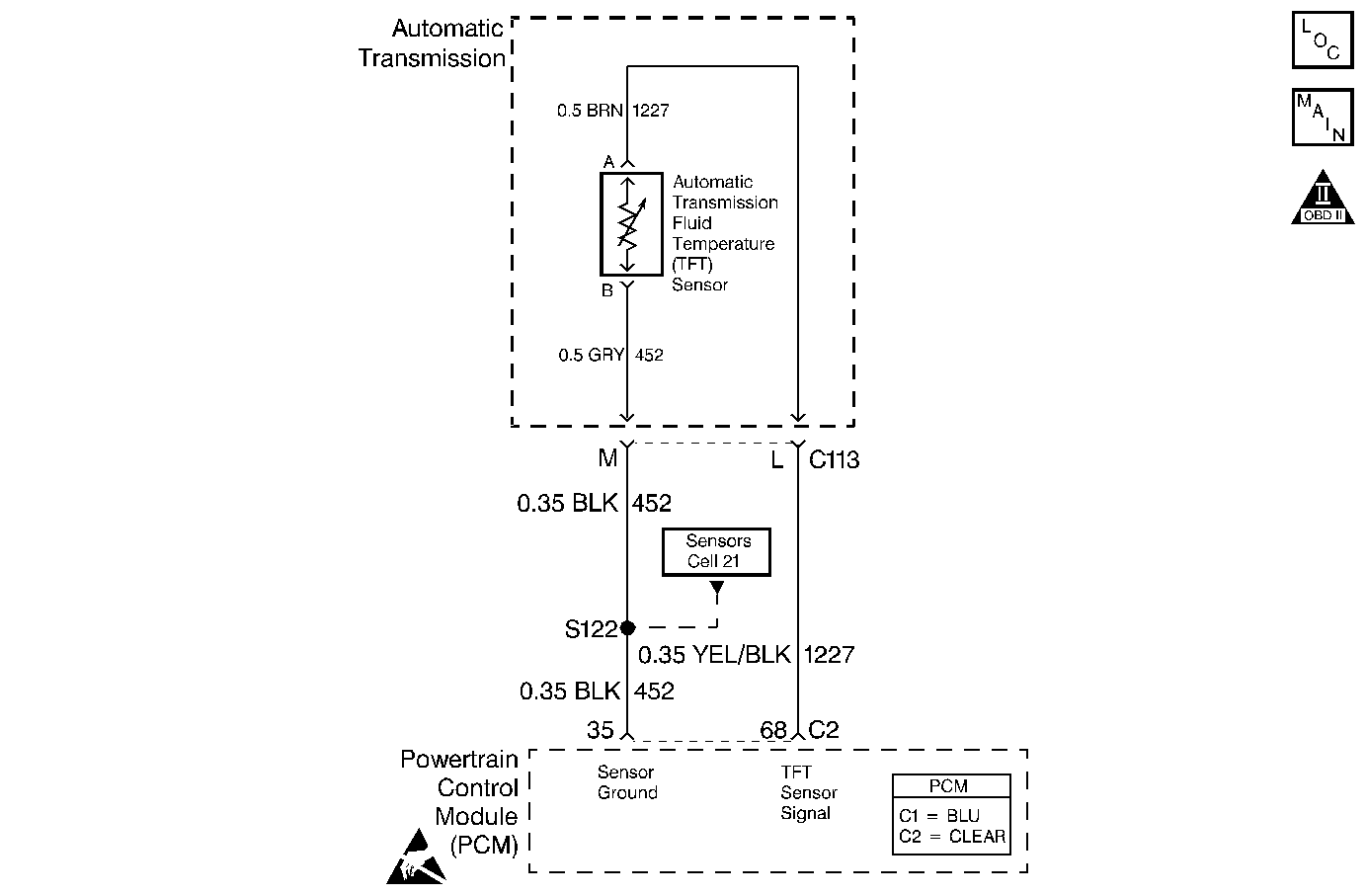
Circuit Description
The automatic transmission fluid temperature (TFT) sensor is a negative coefficient thermistor whose resistance value changes based on temperature. The PCM provides a 5 volt reference to the sensor on circuit 1227. A high fluid temperature or a short to ground on circuit 1227 results in low signal voltage. The TFT operating range is -40 to +151°C (-40 to +304°F).
If the PCM detects a continuous short to ground in TFT sensor circuit 1227, then DTC P0712 sets. DTC P0712 is a type D DTC.
Conditions for Setting the DTC
| • | The system voltage is 9-18 volts. |
| • | The PCM detects a TFT sensor voltage of 0.20 volts or less for 10 seconds. |
Action Taken When the DTC Sets
| • | The PCM does not turn on the Malfunction Indicator Lamp (MIL). |
| • | The PCM freezes shift adapts. |
| • | The PCM calculates a default TFT from the engine coolant temperature (ECT) sensor and the intake air temperature (IAT) sensor. |
| • | The PCM stores DTC P0712 in PCM history. |
Conditions for Clearing the DTC
| • | A scan tool clears the DTC from the PCM history. |
| • | The PCM clears the DTC from the PCM history if the vehicle completes 40 consecutive warm-up cycles without an emission related diagnostic fault occurring. |
| • | The PCM cancels the DTC default actions when the fault no longer exists and the ignition switch is OFF long enough in order to power down the PCM. |
Diagnostic Aids
| • | Inspect the wiring at the PCM, the transmission 20-way connector and all other circuit connecting points for the following conditions: |
| - | A bent terminal |
| - | A backed out terminal |
| - | A damaged terminal |
| - | Poor terminal tension |
| - | A chafed wire |
| - | A broken wire inside the insulation |
| - | Moisture intrusion |
| - | Corrosion |
| • | When diagnosing for an intermittent short to ground or short to power, massage the wiring harness while watching the test equipment for a change. |
| • | Test the TFT sensor at various temperature levels to evaluate the possibility of a skewed (mis-scaled) sensor. Refer to the Temperature vs Resistance table. |
Test Description
The numbers below refer to the step numbers on the diagnostic table.
-
This step tests the PCM's ability to detect an open circuit.
-
This step tests the TFT sensor for correct resistance.
Step | Action | Value(s) | Yes | No | ||||
|---|---|---|---|---|---|---|---|---|
1 | Was the Powertrain On-Board Diagnostic (OBD) System Check performed? | -- | Go to Powertrain On Board Diagnostic (OBD) System Check in Engine Controls | |||||
2 |
Important: Before clearing the DTCs, use the Scan Tool in order to record the Failure Records. Using the Clear Info function erases the Failure Records from the PCM. Does the Scan Tool display a TFT sensor voltage less than specified? | 0.2 volts | Go to Diagnostic Aids | |||||
Does the Scan Tool display a TFT sensor voltage greater than specified? | 4.92 volts | |||||||
4 | Inspect circuit 1227 from the engine 20-way connector to the PCM connector for a short to ground. Refer to General Electrical Diagnosis in Wiring Systems. Was the condition found? | -- | ||||||
Is the resistance within the range specified for the given transmission temperatures? | 20°C (68°F) 3,106-3,923 ohms 100°C (212°F) 164-190 ohms | |||||||
6 | Measure the resistance between terminal L and a good ground on the transmission case. Is the resistance less than the specified value? | 1,000 ohms | Go to Diagnostic Aids | |||||
7 |
Is the resistance less than the specified value? | 1,000 ohms | ||||||
8 | Repair the wiring as necessary. Is the repair complete? | -- | -- | |||||
9 | Replace the TFT sensor. Refer to Solenoids and Wiring Harness Replacement . Is the replacement complete? | -- | -- | |||||
10 | Replace the automatic transmission wiring harness. Refer to Solenoids and Wiring Harness Replacement . Is the replacement complete? | -- | -- | |||||
11 | Replace the PCM. Refer to Powertrain Control Module Replacement/Programming in Engine Controls. Is the replacement complete? | -- | -- | |||||
12 | Perform the following procedure In order to verify the repair:
Has the test run and passed? | -- | System OK |
